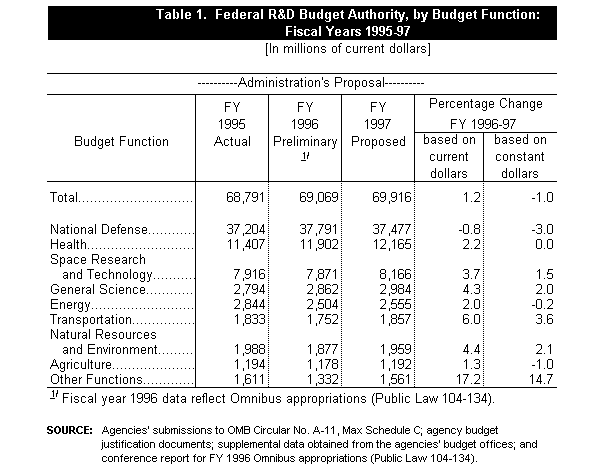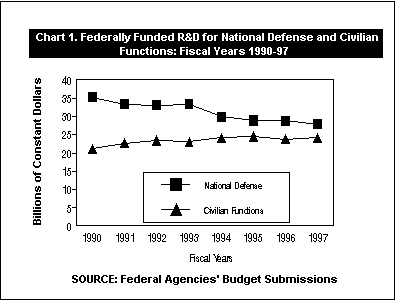L. Meeks
| Science Resources Studies Division | |
| DATA BRIEF |
Directorate for Social, Behavioral and Economic Sciences |
| President's Budget Includes Small Increase for R&D in FY 1997 |
L. Meeks |
The administration has proposed total budget authority of $70 billion for the research and development (R&D) components of agency programs in its fiscal year (FY) 1997 budget. This amount is only 1 percent more than the preliminary FY 1996 R&D total of $69 billion ( table 1). Defense R&D is slated to decline 1 percent in FY 1997 and R&D for nondefense programs is slated to increase 4 percent. After adjusting for expected inflation, total R&D budget authority would decrease by 1 percent. While pending Congressional action will determine the final budget authority for R&D, the information presented here highlights Federal agencies' submissions to the Office of Management and Budget in early 1996. |

|
As of this writing, all of the thirteen FY 1997 appropriations
bills have passed the House, but Senate action is still pending
on more than half of these bills. Details on the President's
requested Federal funding of the R&D components of agency
programs for FYs 1995-97 soon will be available in the annual
report, Federal R&D Funding by Budget Function: Fiscal
Years 1995-97.
Proposed Defense R&D Even with a proposed 1 percent drop in national defense budget authority, defense will account for $37 billion, or 54 percent, of the Federal R&D total. Most (93 percent) of the defense dollars for research, development, test, and evaluation (RDT&E) would be provided by the three armed services (Army, Navy, and Air Force) and defense agencies, notably the Ballistic Missile Defense Organization (BMDO) and the Defense Advanced Research Projects Agency (DARPA). The Department of Defense's (DOD's) R&D budget for FY 1997 is slated to drop by 1 percent (3 percent in constant dollars) to $35 billion over FY 1996. Modest R&D growth (2 percent increase or 0.2 percent decrease in constant dollars) is expected in the Department of Energy's (DOE's) atomic energy defense activities, mainly in support of projects in stockpile stewardship (formerly weapons research, development, and testing) and environmental restoration and waste management programs (formerly threat assessment). Both the House and Senate have passed their versions of defense appropriations bills. The House version adds nearly $3 billion more to the administration's RDT&E request. This includes a $700 million increase for the Ballistic Missile Defense (BMD) program and additional funding for chemical/biological defense programs, battlefield communications and reconnaissance programs, and precision-guided munitions. The Senate version of the bill also adds about $3 billion to the administration's RDT&E request, with an increase of $900 million for the BMD program. Proposed Nondefense R&D Total nondefense R&D budget authority is proposed to increase by $1 billion, to $32 billion. This level would represent a 4 percent increase from estimated 1996 levels. In constant dollars, nondefense R&D is expected to increase 1.5 percent. The nondefense share of Federal R&D budget authority has steadily increased from 37 percent in FY 1990 to 46 percent in FY 1997 (chart1). |

|
Among individual budget functions, the largest FY
1996 to FY 1997 R&D increase (nearly $300 million) is slated
for space research and technology activities of the National Aeronautics
and Space Administration(NASA), to $8 billion or a 4 percent increase over FY 1996 levels. The largest growth in the FY 1997 space research and technology account appears to be the expected allowances ($340 million) for advance
funding of outyear costs for the New Millennium Initiative, which
represents a fundamentally new way for NASA to develop and operate
robotic space missions.
R&D budget authority for health activities, which primarily includes programs of the National Institutes of Health (NIH), is proposed to increase by 2 percent, to over $12 billion. R&D funding increases expected in all of NIH's institutes contribute to this overall gain in FY 1997. The National Cancer Institute is slated to get the largest portion (over $2 billion) of NIH R&D dollars. Only two other components of NIH are expected to receive more than one billion dollars in R&D funding-Office of AIDS Research and the National Heart, Lung, and Blood Institute. A 2 percent increase ($50 million) is intended for energy R&D, to $3 billion in FY 1997. Three agencies provide support for R&D activities in energy: the Department of Energy (DOE), which would account for 96 percent of the funding in this area; the Tennessee Valley Authority; and the Nuclear Regulatory Commission. Energy R&D would comprise 4 percent of the total Federal R&D budget authority, the largest growth being slated for energy conservation (an expected increase of $135 million in funding) and solar energy and renewables (an expected increase of $90 million in funding). Research funding for general science is proposed to increase by 4 percent, or by $122 million in FY 1997, to $3 billion. Three-fourths of these dollars are slated for the National Science Foundation (NSF), with the remainder going to DOE. Major funded activities in NSF include mathematical and physical sciences, geosciences, biological sciences, engineering, computer and information sciences, and social, behavioral and economic sciences. DOE's general science R&D is in support of high energy and nuclear physics. Data Collection Notes The data in the annual report represent agencies' best estimates of actual and proposed Federal funding for R&D collected during the period February through June 1996. These data are based primarily on information that agencies provide to the Office of Management and Budget and account for nearly all federally sponsored R&D activities. Also incorporated in the report is R&D information that became available from the individual agencies after the administration's budget was prepared and reported. Such information consists of agency budget justification documents submitted to Congress and supplemental, program-specific information obtained from agency budget and program staff through June 1996. Therefore, budget numbers for individual activities, programs, or agencies may differ from those published in the President's budget or agency budget documents.
This Data Brief was prepared by Ronald L. Meeks, who may be reached at the following address:
National Science Foundation For free printed copies of SRS Data Briefs, write to the above address, call 703-306-1773, or send e-mail to srspubs@nsf.gov. |